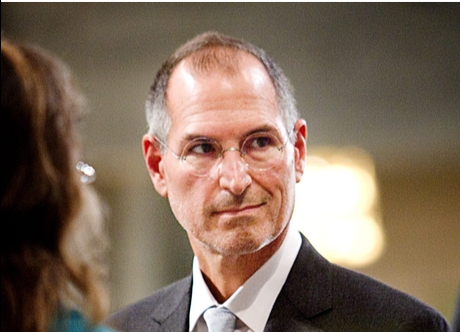Veterans of the Mac team had learned that they could stand up to Jobs.
Mac團(tuán)隊(duì)的資深成員意識(shí)到,他們可以勇敢地面對(duì)喬布斯。
If they knew what they were talking about, he would tolerate the pushback, even admire it.
如果他們清楚自己在說(shuō)什么的話,喬布斯就能容忍反對(duì)的聲音,甚至表達(dá)贊賞之情。
By 1983 those most familiar with his reality distortion field had discovered something further:
到1983年,那些最熟悉他現(xiàn)實(shí)扭曲力場(chǎng)的人有了進(jìn)一步的發(fā)現(xiàn):
They could, if necessary, just quietly disregard what he decreed.
如果必要的話,他們可以不動(dòng)聲色地忽略他的命令。
If they turned out to be right, he would appreciate their renegade attitude and willingness to ignore authority.
如果事實(shí)證明他們是正確的,喬布斯就會(huì)欣賞他們的叛逆態(tài)度和敢于無(wú)視權(quán)威的意愿。
After all, that's what he did.
畢竟,他自己就是這么做的。

By far the most important example of this involved the choice of a disk drive for the Macintosh.
迄今為止,喬布斯的叛逆精神影響的最重大的一次事件,是在為麥金塔選擇磁盤驅(qū)動(dòng)器這件事上。
Apple had a corporate division that built mass-storage devices, and it had developed a disk-drive system, code-named Twiggy,
當(dāng)時(shí)蘋果公司有一個(gè)部門是生產(chǎn)大容量存儲(chǔ)設(shè)備的,他們幵發(fā)了一套磁盤驅(qū)動(dòng)系統(tǒng),代號(hào)崔姬,
that could read and write onto those thin, delicate 5.25-inch floppy disks that older readers (who also remember Twiggy the model) will recall.
它可以讀寫那些纖薄、精致的5.25英寸軟盤,年長(zhǎng)一些的讀者(那些還記得模特崔姬是誰(shuí)的人)一定還能回想起那種軟盤。
But by the time the Lisa was ready to ship in the spring of 1983, it was clear that the Twiggy was buggy.
但到了1983年春天,麗薩準(zhǔn)備上市的時(shí)候,崔姬系統(tǒng)的高故障率已經(jīng)很明顯了。
Because the Lisa also came with a hard-disk drive, this was not a complete disaster.
因?yàn)辂愃_還帶有一個(gè)硬盤驅(qū)動(dòng)器,所以對(duì)它來(lái)說(shuō)情況并不算太糟。
But the Mac had no hard disk, so it faced a crisis.
但Mac沒有硬盤,所以它就面臨著危機(jī)。
"The Mac team was beginning to panic," said Hertzfeld.
“Mac團(tuán)隊(duì)開始感到驚慌了,”赫茨菲爾德說(shuō),
"We were using a single Twiggy drive, and we didn't have a hard disk to fall back on."
“我們只用了一個(gè)崔姬系統(tǒng)作為軟盤驅(qū)動(dòng)器,又沒有硬盤可以備用。”
The team discussed the problem at the January 1983 retreat, and Debi Coleman gave Jobs data about the Twiggy failure rate.
1983年1月,在卡梅爾的那次度假中,他們討論了這個(gè)問(wèn)題,黛比·科爾曼把崔姬系統(tǒng)故障率的數(shù)據(jù)給了喬布斯。
A few days later he drove to Apple's factory in San Jose to see the Twiggy being made.
幾天之后,喬布斯開車來(lái)到蘋果公司在圣何塞的工廠,視察崔姬的生產(chǎn)過(guò)程。
More than half were rejected. Jobs erupted.
生產(chǎn)中的每一個(gè)流程,都有超過(guò)一半的產(chǎn)品不合格。喬布斯憤怒了。
With his face flushed, he began shouting and sputtering about firing everyone who worked there.
他的臉氣得通紅,開始咆哮,氣急敗壞地說(shuō)要開除那兒所有的員工。
Bob Belleville, the head of the Mac engineering team, gently guided him to the parking lot,
Mac工程團(tuán)隊(duì)的負(fù)責(zé)人鮑勃·貝爾維爾平靜地把他帶到了停車場(chǎng),
where they could take a walk and talk about alternatives.
在那兒他們一邊散步一邊討論替代方案。
One possibility that Belleville had been exploring was to use a new 3.5-inch disk drive that Sony had developed.
有一個(gè)辦法,也是貝爾維爾一直在探索的,就是使用索尼公司剛剛研發(fā)的新型3.5英寸磁盤。
The disk was cased in sturdier plastic and could fit into a shirt pocket.
這種磁盤被包裹在更加牢固的塑料中,并且可以塞進(jìn)襯衫口袋。
Another option was to have a clone of Sony's 3.5-inch disk drive manufactured by a smaller Japanese supplier, the Alps Electronics Co.,
還有一個(gè)辦法,就是使用日本的一家小供應(yīng)商--阿爾卑斯電子公司生產(chǎn)的索尼3.5英寸磁盤的仿制品,
which had been supplying disk drives for the Apple II.
這家公司一直為Apple II供應(yīng)磁盤驅(qū)動(dòng)器。
Alps had already licensed the technology from Sony,
阿爾卑斯電子公司當(dāng)時(shí)已經(jīng)獲得了索尼的技術(shù)授權(quán),
and if they could build their own version in time it would be much cheaper.
如果他們能及時(shí)生產(chǎn)出自家版本的驅(qū)動(dòng)器的話,價(jià)格將便宜不少。



